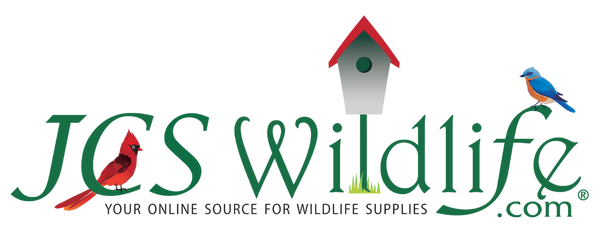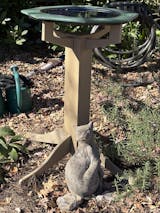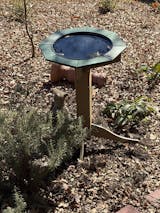If you’ve ever spotted a woodpecker with a golden glow or a flash of red under its wings, chances are you’ve met the Northern Flicker. This quirky, ground-loving woodpecker is a favorite among birders and backyard wildlife enthusiasts alike. At JCS Wildlife, we’re all about helping you attract and support wild birds like the Northern Flicker—and today, we’re diving deep into what makes this bird so special.
1. Who Is the Northern Flicker?
The Northern Flicker (Colaptes auratus) is a medium-sized woodpecker found across North America. Unlike most woodpeckers, flickers spend a lot of time on the ground, hunting for ants and beetles with their long, barbed tongues. They’re easily recognized by their spotted plumage, black bib, and colorful underwings—yellow in the East, red in the West.

2. Northern Flicker Identification Guide
- Size: About 12 inches long, with a wingspan of 16–20 inches.
- Coloration: Brownish body with black spots, crescent-shaped chest patch, and a white rump.
- Underside of Wings: Yellow (Eastern) or red (Western).
- Call: A loud, repeated “wick-a-wick-a-wick” or a sharp “kleer!”

3. Habitat and Range
Northern Flickers are incredibly adaptable. You’ll find them in:
- Forest edges
- Open woodlands
- Parks and suburban backyards
They range from Alaska to Central America, with two main subspecies:
- Yellow-shafted Flicker (East)
- Red-shafted Flicker (West)
In some areas, these subspecies interbreed, creating hybrids with mixed features.

4. What Do Northern Flickers Eat?
Unlike their tree-drilling cousins, flickers prefer foraging on the ground. Their diet includes:
- Ants (their favorite!)
- Beetles
- Caterpillars
- Berries
- Seeds
- Suet
To attract flickers to your yard, try offering suet cakes, mealworms, or fruit blends in platform feeders. JCS Wildlife carries a variety of flicker-friendly feeders and food options.

5. Nesting Habits
Northern Flickers are cavity nesters. They’ll excavate their own nest holes in dead trees or use existing cavities. You can support them by:
- Leaving dead trees (snags) when safe
- Installing nesting boxes designed for woodpeckers
- Avoiding pesticides that reduce insect populations
Our woodpecker nesting boxes are perfect for flickers and other cavity-nesting birds.

6. Fun Flicker Facts: Quirky, Colorful, and Totally Unique
- Ant Addict: Northern Flickers eat more ants than any other North American bird.
- Tongue Trickery: Their tongue can extend up to 2 inches beyond their beak and is coated in sticky saliva.
- Metalhead Drummer: Flickers love to drum on metal objects like gutters and satellite dishes to attract mates.
- Hybrid Zone Wonders: Yellow-shafted and Red-shafted flickers interbreed in the Great Plains, creating hybrids.
- Ground Dancer: Flickers hop around on the ground while foraging for bugs.
- Compass Tail: Their white rump patch acts like a beacon in flight.
- Polka-Dot Plumage: Their spotted belly and chest patch give them a retro look.
- Cavity Nesters: They lay 5–8 eggs and both parents share incubation duties.
- Smart Foragers: Flickers use tools like flicking leaves to expose ant colonies.
- Ant Bathing: They engage in anting to clean parasites off their feathers.
- Partial Migrants: Migration depends on food availability and climate.
- Colorful Divide: Eastern flickers flash yellow, Western flickers flash red.
- Vocal Variety: Their calls range from “wick-a-wick-a-wick” to “kleer!” and “churr.”

7. Northern Flicker vs. Other Woodpeckers
| Species | Size | Foraging Style | Distinctive Trait |
|---|---|---|---|
| Northern Flicker | 12" | Ground forager | Yellow/red underwings |
| Downy Woodpecker | 6.5" | Tree driller | Smallest woodpecker |
| Hairy Woodpecker | 9" | Tree driller | Longer bill than Downy |
| Pileated Woodpecker | 16–19" | Tree excavator | Striking red crest |
8. How to Attract Northern Flickers to Your Yard
- Offer suet and mealworms in platform or open feeders.
- Provide water with bird baths or drippers.
- Install nesting boxes in quiet, wooded areas.
- Avoid pesticides to keep insect populations healthy.
- Leave leaf litter for natural foraging.
Check out our flicker-friendly feeders and nesting boxes in the JCS Wildlife shop!

9. Seasonal Behavior and Migration
Northern Flickers are partial migrants. In colder regions, they head south for the winter. In milder climates, they may stick around year-round. You’ll notice:
- Spring: Loud drumming and courtship displays.
- Summer: Nesting and feeding young.
- Fall: Increased ground foraging.
- Winter: Visiting feeders more often.
Keep your feeders stocked with high-fat foods like suet during colder months.

10. Conservation Status
Good news: Northern Flickers are not endangered. However, habitat loss and pesticide use can impact local populations. Supporting flickers means:
- Preserving natural habitats
- Providing nesting sites
- Offering safe, nutritious food
JCS Wildlife is proud to offer eco-friendly products that help you support wild birds responsibly.

11. Northern Flickers and Backyard Birding
Flickers are a joy to watch. Their quirky behavior, flashy feathers, and loud calls make them a standout in any backyard. Whether you're a seasoned birder or just getting started, flickers are a great species to observe and support.
Want to share your flicker sightings? Tag us on social media or send us your photos—we love seeing our customers connect with nature!

12. Shop Flicker-Friendly Products
Ready to welcome Northern Flickers to your yard? Browse our top picks:
Final Thoughts
The Northern Flicker is a fascinating, fun-loving woodpecker that brings life and color to backyards across North America. With the right setup, you can enjoy their antics year-round. At JCS Wildlife, we’re here to help you create a bird-friendly haven—one flicker at a time.





